Analyzing Nursing Standards & Clinical Experiences in Practice
VerifiedAdded on 2023/06/04
|7
|1798
|296
Essay
AI Summary
This essay provides an in-depth analysis of nursing practice standards, particularly focusing on standards 5 and 6, and their relevance to clinical experiences. It discusses the importance of patient satisfaction, adherence to certified standards, and the role of registered nurses in providing quality healthcare. Standard 5 is examined for its role in establishing relevant plans and managing health and safety, while standard 6 emphasizes safe, relevant, and responsive nursing practice. The essay draws on undergraduate clinical experiences to illustrate the application of these standards, such as maintaining accurate health records and effectively managing patient care, including monitoring blood pressure and respiratory rates. It also addresses the significance of continuous supervision and adherence to guidelines and regulations to ensure patient safety and quality clinical care. The essay concludes by highlighting the benefits of upholding these standards, emphasizing the need for patient confidentiality, privacy, and security to ensure patient satisfaction.
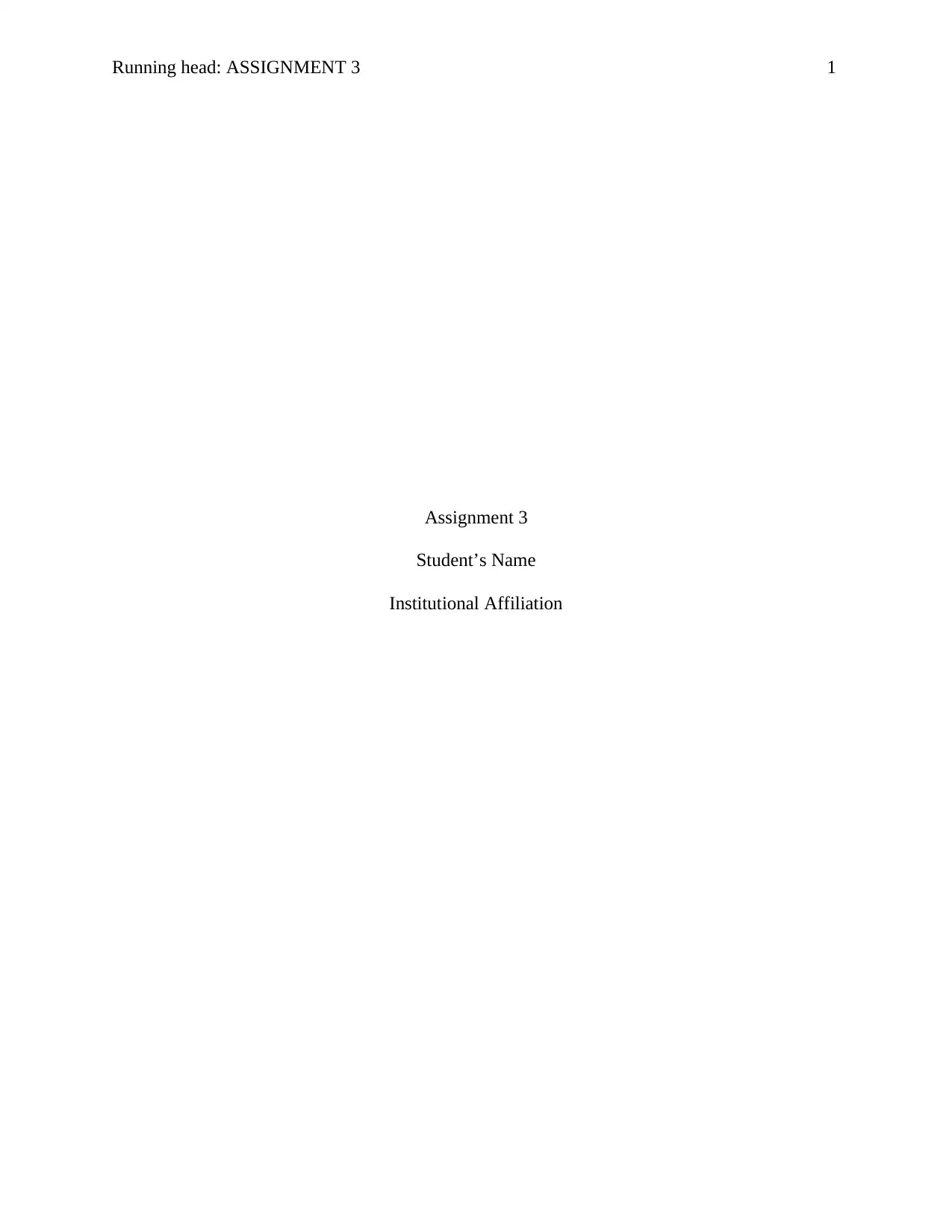
Running head: ASSIGNMENT 3 1
Assignment 3
Student’s Name
Institutional Affiliation
Assignment 3
Student’s Name
Institutional Affiliation
Paraphrase This Document
Need a fresh take? Get an instant paraphrase of this document with our AI Paraphraser
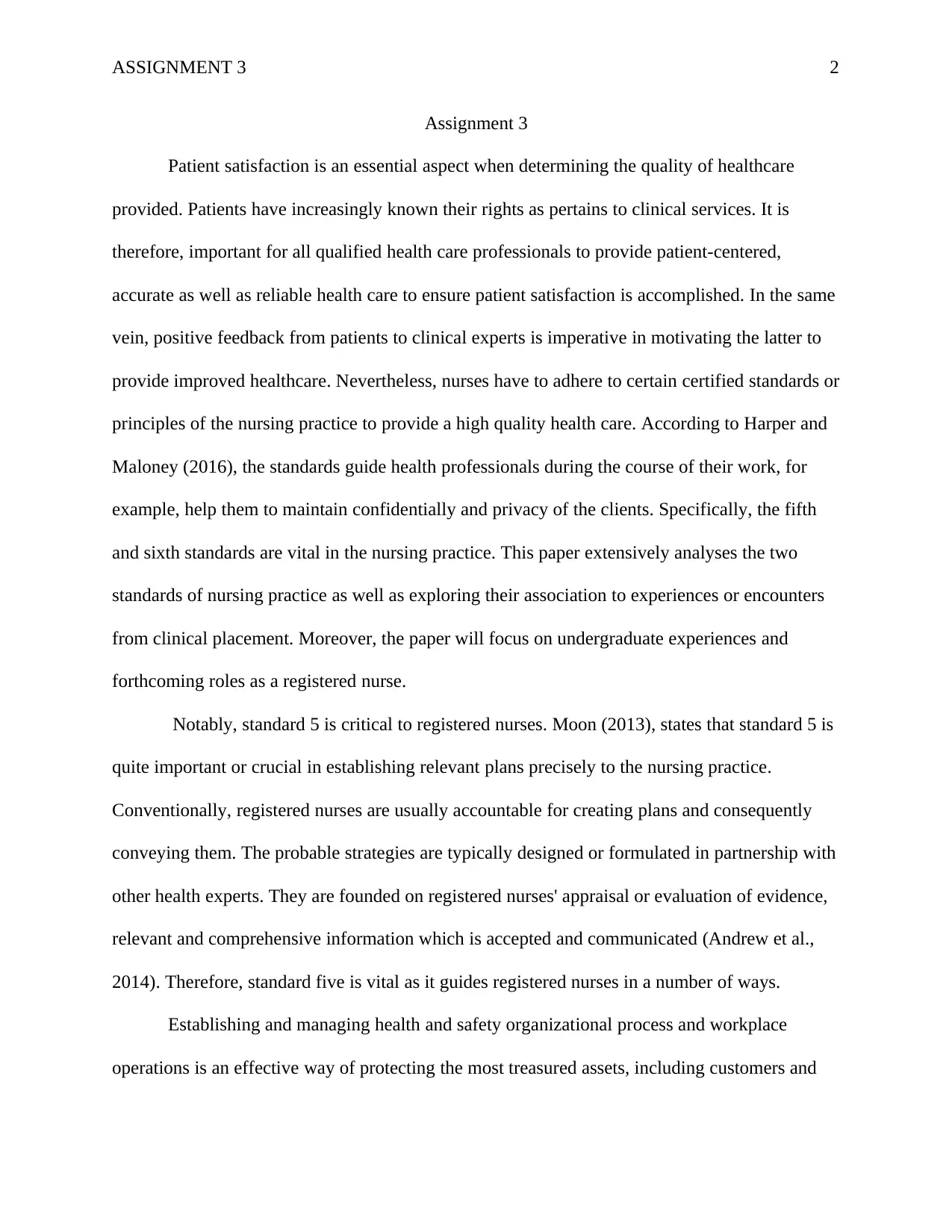
ASSIGNMENT 3 2
Assignment 3
Patient satisfaction is an essential aspect when determining the quality of healthcare
provided. Patients have increasingly known their rights as pertains to clinical services. It is
therefore, important for all qualified health care professionals to provide patient-centered,
accurate as well as reliable health care to ensure patient satisfaction is accomplished. In the same
vein, positive feedback from patients to clinical experts is imperative in motivating the latter to
provide improved healthcare. Nevertheless, nurses have to adhere to certain certified standards or
principles of the nursing practice to provide a high quality health care. According to Harper and
Maloney (2016), the standards guide health professionals during the course of their work, for
example, help them to maintain confidentially and privacy of the clients. Specifically, the fifth
and sixth standards are vital in the nursing practice. This paper extensively analyses the two
standards of nursing practice as well as exploring their association to experiences or encounters
from clinical placement. Moreover, the paper will focus on undergraduate experiences and
forthcoming roles as a registered nurse.
Notably, standard 5 is critical to registered nurses. Moon (2013), states that standard 5 is
quite important or crucial in establishing relevant plans precisely to the nursing practice.
Conventionally, registered nurses are usually accountable for creating plans and consequently
conveying them. The probable strategies are typically designed or formulated in partnership with
other health experts. They are founded on registered nurses' appraisal or evaluation of evidence,
relevant and comprehensive information which is accepted and communicated (Andrew et al.,
2014). Therefore, standard five is vital as it guides registered nurses in a number of ways.
Establishing and managing health and safety organizational process and workplace
operations is an effective way of protecting the most treasured assets, including customers and
Assignment 3
Patient satisfaction is an essential aspect when determining the quality of healthcare
provided. Patients have increasingly known their rights as pertains to clinical services. It is
therefore, important for all qualified health care professionals to provide patient-centered,
accurate as well as reliable health care to ensure patient satisfaction is accomplished. In the same
vein, positive feedback from patients to clinical experts is imperative in motivating the latter to
provide improved healthcare. Nevertheless, nurses have to adhere to certain certified standards or
principles of the nursing practice to provide a high quality health care. According to Harper and
Maloney (2016), the standards guide health professionals during the course of their work, for
example, help them to maintain confidentially and privacy of the clients. Specifically, the fifth
and sixth standards are vital in the nursing practice. This paper extensively analyses the two
standards of nursing practice as well as exploring their association to experiences or encounters
from clinical placement. Moreover, the paper will focus on undergraduate experiences and
forthcoming roles as a registered nurse.
Notably, standard 5 is critical to registered nurses. Moon (2013), states that standard 5 is
quite important or crucial in establishing relevant plans precisely to the nursing practice.
Conventionally, registered nurses are usually accountable for creating plans and consequently
conveying them. The probable strategies are typically designed or formulated in partnership with
other health experts. They are founded on registered nurses' appraisal or evaluation of evidence,
relevant and comprehensive information which is accepted and communicated (Andrew et al.,
2014). Therefore, standard five is vital as it guides registered nurses in a number of ways.
Establishing and managing health and safety organizational process and workplace
operations is an effective way of protecting the most treasured assets, including customers and
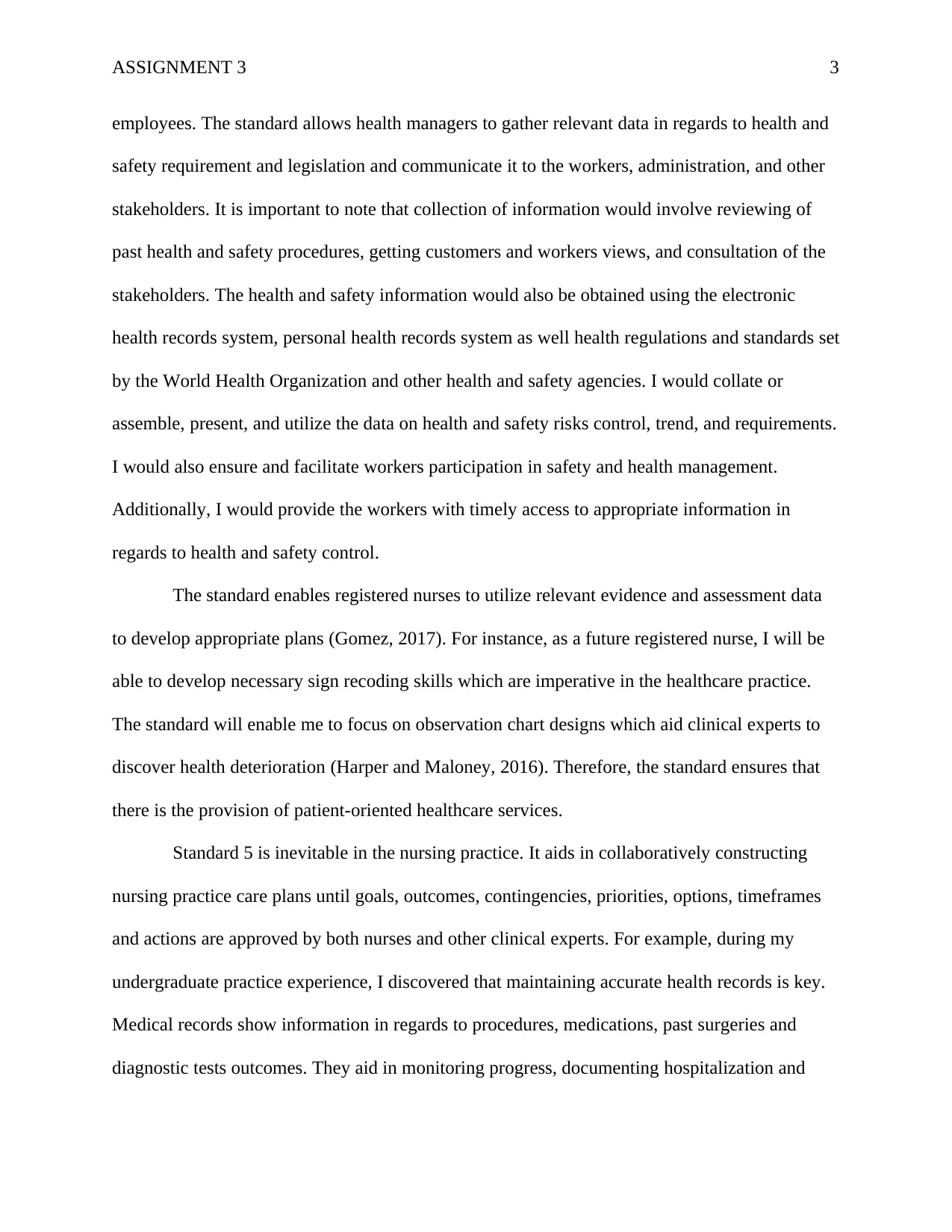
ASSIGNMENT 3 3
employees. The standard allows health managers to gather relevant data in regards to health and
safety requirement and legislation and communicate it to the workers, administration, and other
stakeholders. It is important to note that collection of information would involve reviewing of
past health and safety procedures, getting customers and workers views, and consultation of the
stakeholders. The health and safety information would also be obtained using the electronic
health records system, personal health records system as well health regulations and standards set
by the World Health Organization and other health and safety agencies. I would collate or
assemble, present, and utilize the data on health and safety risks control, trend, and requirements.
I would also ensure and facilitate workers participation in safety and health management.
Additionally, I would provide the workers with timely access to appropriate information in
regards to health and safety control.
The standard enables registered nurses to utilize relevant evidence and assessment data
to develop appropriate plans (Gomez, 2017). For instance, as a future registered nurse, I will be
able to develop necessary sign recoding skills which are imperative in the healthcare practice.
The standard will enable me to focus on observation chart designs which aid clinical experts to
discover health deterioration (Harper and Maloney, 2016). Therefore, the standard ensures that
there is the provision of patient-oriented healthcare services.
Standard 5 is inevitable in the nursing practice. It aids in collaboratively constructing
nursing practice care plans until goals, outcomes, contingencies, priorities, options, timeframes
and actions are approved by both nurses and other clinical experts. For example, during my
undergraduate practice experience, I discovered that maintaining accurate health records is key.
Medical records show information in regards to procedures, medications, past surgeries and
diagnostic tests outcomes. They aid in monitoring progress, documenting hospitalization and
employees. The standard allows health managers to gather relevant data in regards to health and
safety requirement and legislation and communicate it to the workers, administration, and other
stakeholders. It is important to note that collection of information would involve reviewing of
past health and safety procedures, getting customers and workers views, and consultation of the
stakeholders. The health and safety information would also be obtained using the electronic
health records system, personal health records system as well health regulations and standards set
by the World Health Organization and other health and safety agencies. I would collate or
assemble, present, and utilize the data on health and safety risks control, trend, and requirements.
I would also ensure and facilitate workers participation in safety and health management.
Additionally, I would provide the workers with timely access to appropriate information in
regards to health and safety control.
The standard enables registered nurses to utilize relevant evidence and assessment data
to develop appropriate plans (Gomez, 2017). For instance, as a future registered nurse, I will be
able to develop necessary sign recoding skills which are imperative in the healthcare practice.
The standard will enable me to focus on observation chart designs which aid clinical experts to
discover health deterioration (Harper and Maloney, 2016). Therefore, the standard ensures that
there is the provision of patient-oriented healthcare services.
Standard 5 is inevitable in the nursing practice. It aids in collaboratively constructing
nursing practice care plans until goals, outcomes, contingencies, priorities, options, timeframes
and actions are approved by both nurses and other clinical experts. For example, during my
undergraduate practice experience, I discovered that maintaining accurate health records is key.
Medical records show information in regards to procedures, medications, past surgeries and
diagnostic tests outcomes. They aid in monitoring progress, documenting hospitalization and
⊘ This is a preview!⊘
Do you want full access?
Subscribe today to unlock all pages.

Trusted by 1+ million students worldwide
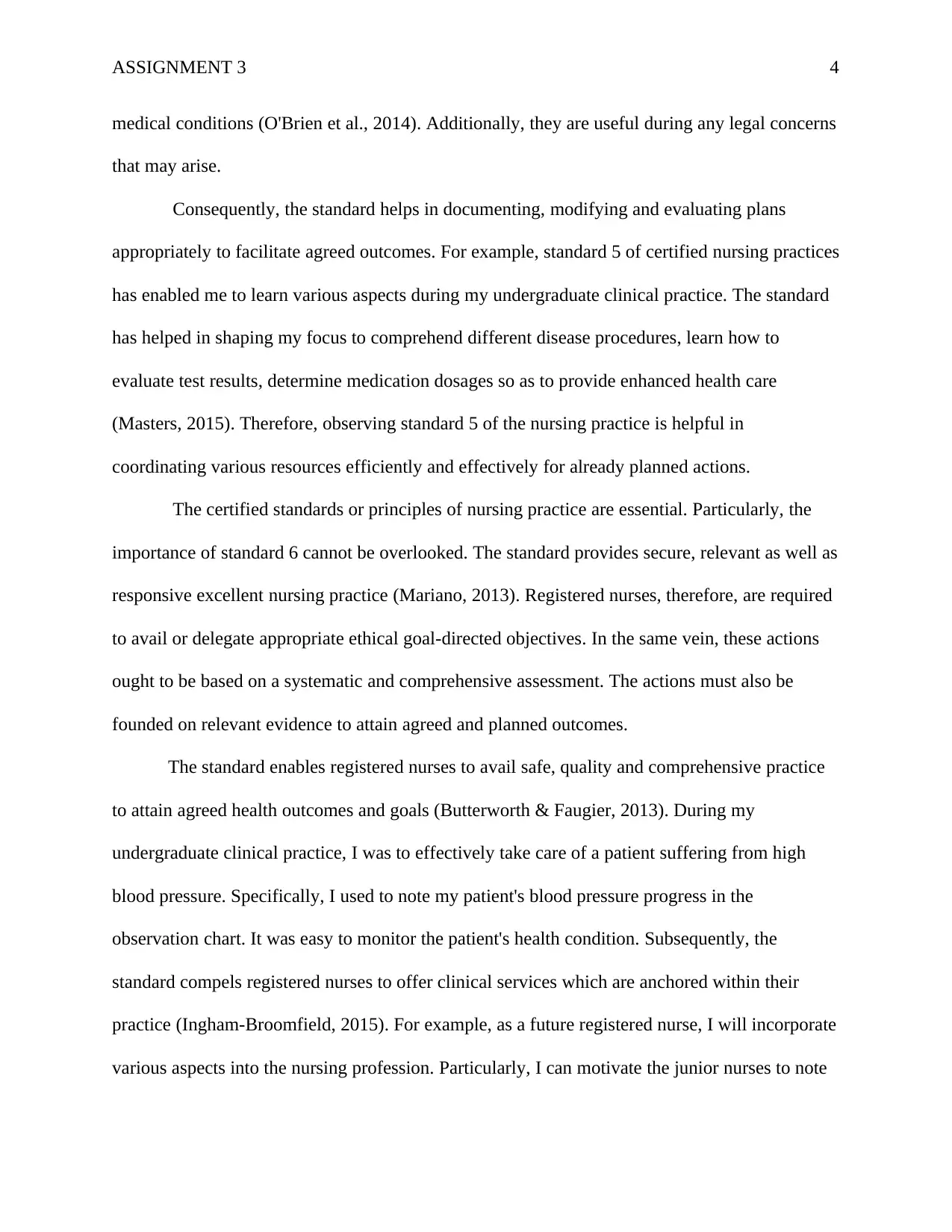
ASSIGNMENT 3 4
medical conditions (O'Brien et al., 2014). Additionally, they are useful during any legal concerns
that may arise.
Consequently, the standard helps in documenting, modifying and evaluating plans
appropriately to facilitate agreed outcomes. For example, standard 5 of certified nursing practices
has enabled me to learn various aspects during my undergraduate clinical practice. The standard
has helped in shaping my focus to comprehend different disease procedures, learn how to
evaluate test results, determine medication dosages so as to provide enhanced health care
(Masters, 2015). Therefore, observing standard 5 of the nursing practice is helpful in
coordinating various resources efficiently and effectively for already planned actions.
The certified standards or principles of nursing practice are essential. Particularly, the
importance of standard 6 cannot be overlooked. The standard provides secure, relevant as well as
responsive excellent nursing practice (Mariano, 2013). Registered nurses, therefore, are required
to avail or delegate appropriate ethical goal-directed objectives. In the same vein, these actions
ought to be based on a systematic and comprehensive assessment. The actions must also be
founded on relevant evidence to attain agreed and planned outcomes.
The standard enables registered nurses to avail safe, quality and comprehensive practice
to attain agreed health outcomes and goals (Butterworth & Faugier, 2013). During my
undergraduate clinical practice, I was to effectively take care of a patient suffering from high
blood pressure. Specifically, I used to note my patient's blood pressure progress in the
observation chart. It was easy to monitor the patient's health condition. Subsequently, the
standard compels registered nurses to offer clinical services which are anchored within their
practice (Ingham-Broomfield, 2015). For example, as a future registered nurse, I will incorporate
various aspects into the nursing profession. Particularly, I can motivate the junior nurses to note
medical conditions (O'Brien et al., 2014). Additionally, they are useful during any legal concerns
that may arise.
Consequently, the standard helps in documenting, modifying and evaluating plans
appropriately to facilitate agreed outcomes. For example, standard 5 of certified nursing practices
has enabled me to learn various aspects during my undergraduate clinical practice. The standard
has helped in shaping my focus to comprehend different disease procedures, learn how to
evaluate test results, determine medication dosages so as to provide enhanced health care
(Masters, 2015). Therefore, observing standard 5 of the nursing practice is helpful in
coordinating various resources efficiently and effectively for already planned actions.
The certified standards or principles of nursing practice are essential. Particularly, the
importance of standard 6 cannot be overlooked. The standard provides secure, relevant as well as
responsive excellent nursing practice (Mariano, 2013). Registered nurses, therefore, are required
to avail or delegate appropriate ethical goal-directed objectives. In the same vein, these actions
ought to be based on a systematic and comprehensive assessment. The actions must also be
founded on relevant evidence to attain agreed and planned outcomes.
The standard enables registered nurses to avail safe, quality and comprehensive practice
to attain agreed health outcomes and goals (Butterworth & Faugier, 2013). During my
undergraduate clinical practice, I was to effectively take care of a patient suffering from high
blood pressure. Specifically, I used to note my patient's blood pressure progress in the
observation chart. It was easy to monitor the patient's health condition. Subsequently, the
standard compels registered nurses to offer clinical services which are anchored within their
practice (Ingham-Broomfield, 2015). For example, as a future registered nurse, I will incorporate
various aspects into the nursing profession. Particularly, I can motivate the junior nurses to note
Paraphrase This Document
Need a fresh take? Get an instant paraphrase of this document with our AI Paraphraser
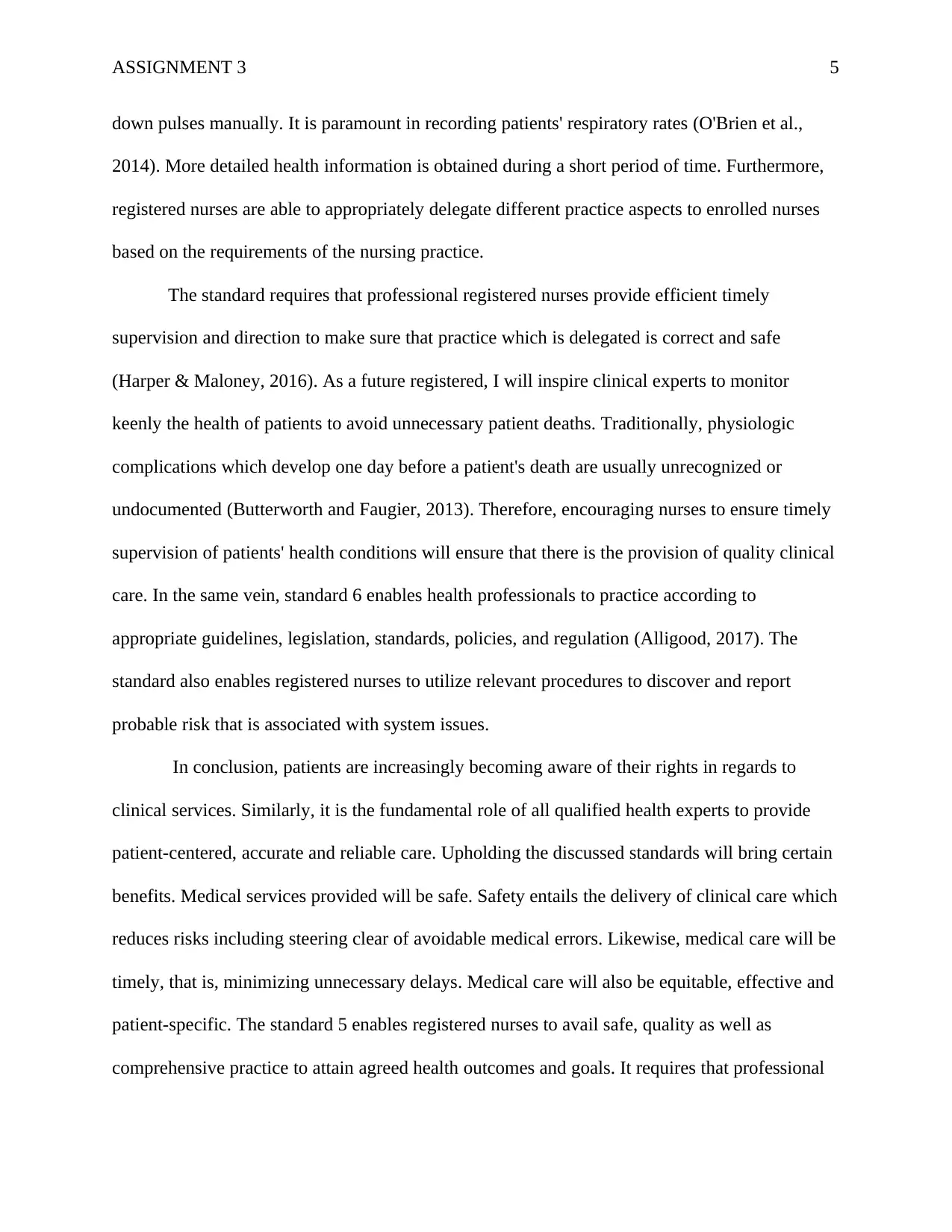
ASSIGNMENT 3 5
down pulses manually. It is paramount in recording patients' respiratory rates (O'Brien et al.,
2014). More detailed health information is obtained during a short period of time. Furthermore,
registered nurses are able to appropriately delegate different practice aspects to enrolled nurses
based on the requirements of the nursing practice.
The standard requires that professional registered nurses provide efficient timely
supervision and direction to make sure that practice which is delegated is correct and safe
(Harper & Maloney, 2016). As a future registered, I will inspire clinical experts to monitor
keenly the health of patients to avoid unnecessary patient deaths. Traditionally, physiologic
complications which develop one day before a patient's death are usually unrecognized or
undocumented (Butterworth and Faugier, 2013). Therefore, encouraging nurses to ensure timely
supervision of patients' health conditions will ensure that there is the provision of quality clinical
care. In the same vein, standard 6 enables health professionals to practice according to
appropriate guidelines, legislation, standards, policies, and regulation (Alligood, 2017). The
standard also enables registered nurses to utilize relevant procedures to discover and report
probable risk that is associated with system issues.
In conclusion, patients are increasingly becoming aware of their rights in regards to
clinical services. Similarly, it is the fundamental role of all qualified health experts to provide
patient-centered, accurate and reliable care. Upholding the discussed standards will bring certain
benefits. Medical services provided will be safe. Safety entails the delivery of clinical care which
reduces risks including steering clear of avoidable medical errors. Likewise, medical care will be
timely, that is, minimizing unnecessary delays. Medical care will also be equitable, effective and
patient-specific. The standard 5 enables registered nurses to avail safe, quality as well as
comprehensive practice to attain agreed health outcomes and goals. It requires that professional
down pulses manually. It is paramount in recording patients' respiratory rates (O'Brien et al.,
2014). More detailed health information is obtained during a short period of time. Furthermore,
registered nurses are able to appropriately delegate different practice aspects to enrolled nurses
based on the requirements of the nursing practice.
The standard requires that professional registered nurses provide efficient timely
supervision and direction to make sure that practice which is delegated is correct and safe
(Harper & Maloney, 2016). As a future registered, I will inspire clinical experts to monitor
keenly the health of patients to avoid unnecessary patient deaths. Traditionally, physiologic
complications which develop one day before a patient's death are usually unrecognized or
undocumented (Butterworth and Faugier, 2013). Therefore, encouraging nurses to ensure timely
supervision of patients' health conditions will ensure that there is the provision of quality clinical
care. In the same vein, standard 6 enables health professionals to practice according to
appropriate guidelines, legislation, standards, policies, and regulation (Alligood, 2017). The
standard also enables registered nurses to utilize relevant procedures to discover and report
probable risk that is associated with system issues.
In conclusion, patients are increasingly becoming aware of their rights in regards to
clinical services. Similarly, it is the fundamental role of all qualified health experts to provide
patient-centered, accurate and reliable care. Upholding the discussed standards will bring certain
benefits. Medical services provided will be safe. Safety entails the delivery of clinical care which
reduces risks including steering clear of avoidable medical errors. Likewise, medical care will be
timely, that is, minimizing unnecessary delays. Medical care will also be equitable, effective and
patient-specific. The standard 5 enables registered nurses to avail safe, quality as well as
comprehensive practice to attain agreed health outcomes and goals. It requires that professional
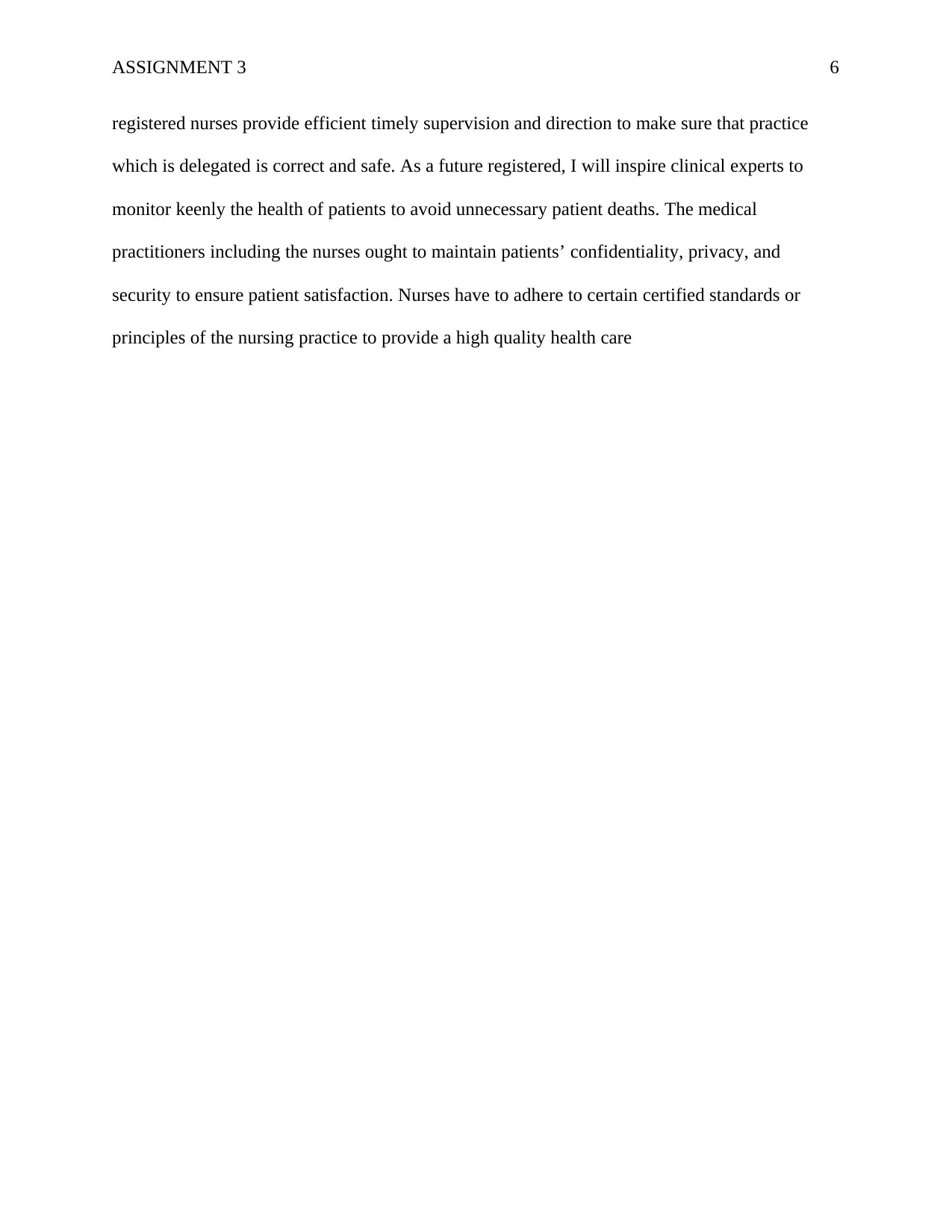
ASSIGNMENT 3 6
registered nurses provide efficient timely supervision and direction to make sure that practice
which is delegated is correct and safe. As a future registered, I will inspire clinical experts to
monitor keenly the health of patients to avoid unnecessary patient deaths. The medical
practitioners including the nurses ought to maintain patients’ confidentiality, privacy, and
security to ensure patient satisfaction. Nurses have to adhere to certain certified standards or
principles of the nursing practice to provide a high quality health care
registered nurses provide efficient timely supervision and direction to make sure that practice
which is delegated is correct and safe. As a future registered, I will inspire clinical experts to
monitor keenly the health of patients to avoid unnecessary patient deaths. The medical
practitioners including the nurses ought to maintain patients’ confidentiality, privacy, and
security to ensure patient satisfaction. Nurses have to adhere to certain certified standards or
principles of the nursing practice to provide a high quality health care
⊘ This is a preview!⊘
Do you want full access?
Subscribe today to unlock all pages.

Trusted by 1+ million students worldwide
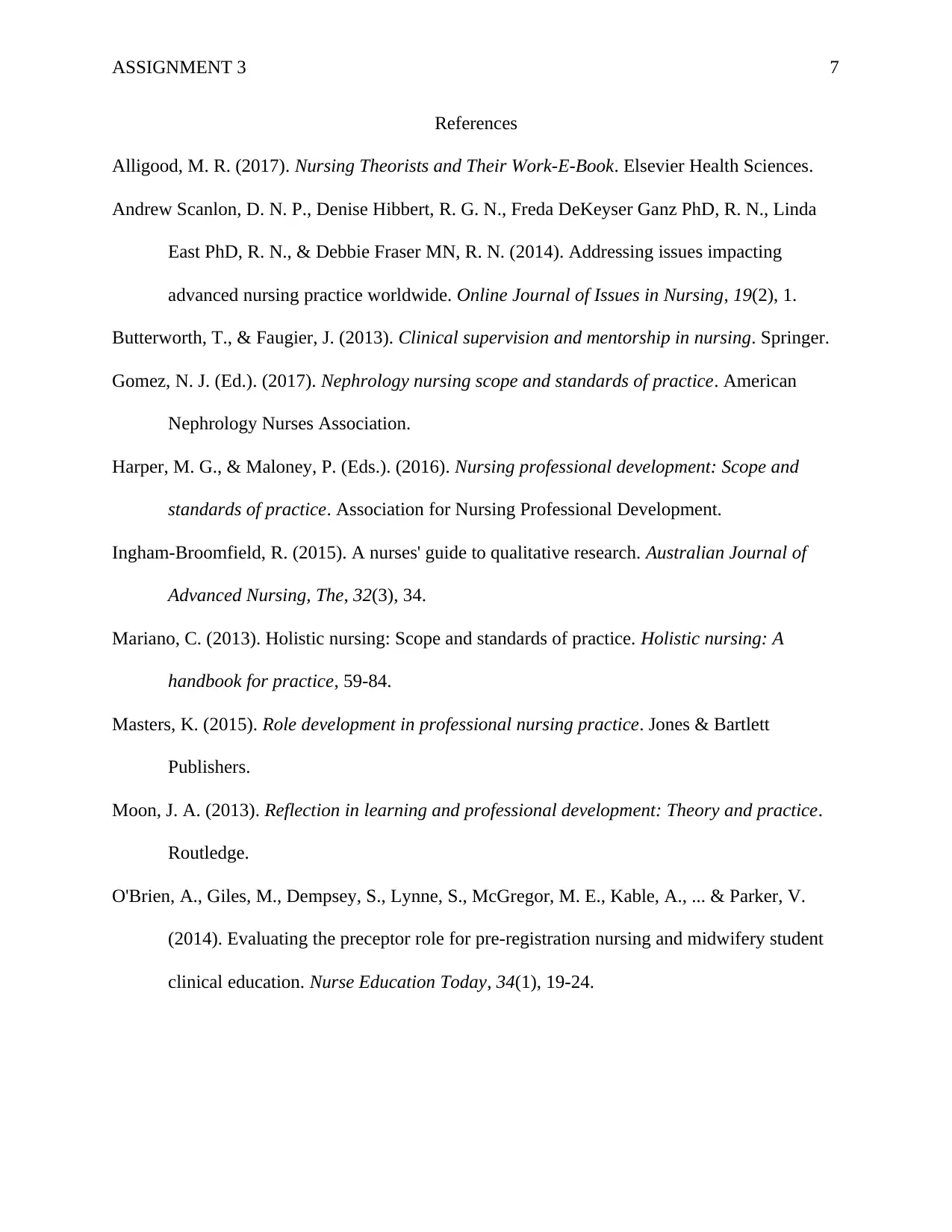
ASSIGNMENT 3 7
References
Alligood, M. R. (2017). Nursing Theorists and Their Work-E-Book. Elsevier Health Sciences.
Andrew Scanlon, D. N. P., Denise Hibbert, R. G. N., Freda DeKeyser Ganz PhD, R. N., Linda
East PhD, R. N., & Debbie Fraser MN, R. N. (2014). Addressing issues impacting
advanced nursing practice worldwide. Online Journal of Issues in Nursing, 19(2), 1.
Butterworth, T., & Faugier, J. (2013). Clinical supervision and mentorship in nursing. Springer.
Gomez, N. J. (Ed.). (2017). Nephrology nursing scope and standards of practice. American
Nephrology Nurses Association.
Harper, M. G., & Maloney, P. (Eds.). (2016). Nursing professional development: Scope and
standards of practice. Association for Nursing Professional Development.
Ingham-Broomfield, R. (2015). A nurses' guide to qualitative research. Australian Journal of
Advanced Nursing, The, 32(3), 34.
Mariano, C. (2013). Holistic nursing: Scope and standards of practice. Holistic nursing: A
handbook for practice, 59-84.
Masters, K. (2015). Role development in professional nursing practice. Jones & Bartlett
Publishers.
Moon, J. A. (2013). Reflection in learning and professional development: Theory and practice.
Routledge.
O'Brien, A., Giles, M., Dempsey, S., Lynne, S., McGregor, M. E., Kable, A., ... & Parker, V.
(2014). Evaluating the preceptor role for pre-registration nursing and midwifery student
clinical education. Nurse Education Today, 34(1), 19-24.
References
Alligood, M. R. (2017). Nursing Theorists and Their Work-E-Book. Elsevier Health Sciences.
Andrew Scanlon, D. N. P., Denise Hibbert, R. G. N., Freda DeKeyser Ganz PhD, R. N., Linda
East PhD, R. N., & Debbie Fraser MN, R. N. (2014). Addressing issues impacting
advanced nursing practice worldwide. Online Journal of Issues in Nursing, 19(2), 1.
Butterworth, T., & Faugier, J. (2013). Clinical supervision and mentorship in nursing. Springer.
Gomez, N. J. (Ed.). (2017). Nephrology nursing scope and standards of practice. American
Nephrology Nurses Association.
Harper, M. G., & Maloney, P. (Eds.). (2016). Nursing professional development: Scope and
standards of practice. Association for Nursing Professional Development.
Ingham-Broomfield, R. (2015). A nurses' guide to qualitative research. Australian Journal of
Advanced Nursing, The, 32(3), 34.
Mariano, C. (2013). Holistic nursing: Scope and standards of practice. Holistic nursing: A
handbook for practice, 59-84.
Masters, K. (2015). Role development in professional nursing practice. Jones & Bartlett
Publishers.
Moon, J. A. (2013). Reflection in learning and professional development: Theory and practice.
Routledge.
O'Brien, A., Giles, M., Dempsey, S., Lynne, S., McGregor, M. E., Kable, A., ... & Parker, V.
(2014). Evaluating the preceptor role for pre-registration nursing and midwifery student
clinical education. Nurse Education Today, 34(1), 19-24.
1 out of 7
Related Documents
Your All-in-One AI-Powered Toolkit for Academic Success.
+13062052269
info@desklib.com
Available 24*7 on WhatsApp / Email
![[object Object]](/_next/static/media/star-bottom.7253800d.svg)
Unlock your academic potential
Copyright © 2020–2025 A2Z Services. All Rights Reserved. Developed and managed by ZUCOL.





